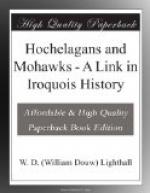“Their first station on the south side of the lakes was at the mouth of the Oswego River.[2] Advancing to the southeast, the emigrants struck the River Hudson” and thence the ocean. “Most of them returned to the Mohawk River, where the Huron speech was altered to Mohawk. In Iroquois tradition and in the constitution of their League the Canienga (Mohawk) nation ranks as ‘eldest brother’ of the family. A comparison of the dialects proves this tradition to be well founded. The Canienga language approaches nearest to the Huron, and is undoubtedly the source from which all the other Iroquois dialects are derived. Cusick states positively that the other families, as he styles them, of the Iroquois household, leaving the Mohawks in their original abode, proceeded step by step to the westward. The Oneidas halted at their creek, the Onondagas at their mountain, the Cayugas at their lake and the Senecas or Sonontowans, the great hill people, at a lofty eminence which rises south of the Canandaigua Lake.” Hale appeals also to the Wyandot tradition recorded by Peter Dooyentate Clark, that the Huron originally lived about Montreal near the “Senecas,” until war broke out and drove them westward. He sets the formation of the League of the Long House as far back as the fourteenth century.
All these authors, it will be seen, together with every historian who has referred to the League,—treat of the Five Nations as always having been one people. A very different view, based principally on archaeology, has however been recently accepted by at least several of the leading authorities on the subject,—the view that the Iroquois League was a compound of two distinct peoples, the Mohawks, in the east, including the Oneidas; and the Senecas, in the west, including the Onondagas and Cayugas. Rev. W.M. Beauchamp, of Baldwinsville, the most thorough living student of the matter, first suggested a late date for the coming of the Mohawks and formation of the League. He had noticed that the three Seneca dialects differed very greatly from the two Mohawk, and that while the local relics of the former showed they had been long settled in their country, those of the latter evidenced a very recent occupation. He had several battles with Hale on the subject, the




